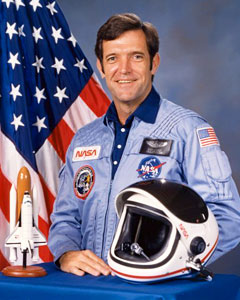
Birthplace: Cle Elum, Washington, May 19, 1939
Challenger Position: Commander
Education: Enlisted in the U.S. Air Force in 1957 after finishing high school; attended night school while stationed in Texas earning two years of college credit; awarded a scholarship through the Airman's Education and Commissioning program; graduated with a degree in Aerospace Engineering from the University of Arizona in 1965.
Honors: Awarded the Air Force Distinguished Flying Cross, the Air Medal, and two NASA Exceptional Service Medals
The commander on mission STS 51-L was Francis R. Scobee. He was born on May 19, 199 in Cle Elum, Washington. He enjoyed flying, oil painting, woodworking, motorcycling, racquetball, jogging, and most outdoor sports. He attended high school at Auburn Senior High School in Auburn, Washington, and graduated in 1957. He enlisted in the United States Air Force later that same year, where he served at Kelly Air Force Base in Texas as a reciprocating engine mechanic. During this time he attended night school at San Antonio College and received enough credit to be selected for the Airman’s Education and Commissioning Program. He then went to the University of Arizona where he received a Bachelor of Science degree in aerospace engineering in 1965. He received his officer's commission later that year and then earned his wings 1966. He then served as a combat aviator in the Vietnam War where he was awarded the Distinguished Flying Cross and the Air Medal. After returning from his tour of duty, Scobee attended the U.S. Air Force Aerospace Research Pilot School at Edwards Air Force Base, California. He graduated in 1972 and became an Air Force test pilot. As a test pilot, he few more than 45 types of aircraft and logged more than 6,500 hours of flight time.
1n 1978 Scobee was selected as an astronaut candidate by NASA. He completed his training in 1979 and became eligible for assignment as a pilot for the Space Shuttle. During this time, he served as an instructor pilot for the shuttle's 747 carrier aircraft. His first flight into space was in 1984 when he served as pilot on Space Shuttle mission STS 41-C. This was the fifth mission for Challenger. During this seven-day mission, the crew successfully retrieved and repaired the Solar Maximum Satellite and returned it to orbit. This was an important mission because it demonstrated the shuttle's capability to repair satellites in orbit.
Scobee was selected to be commander for Challenger mission STS 51-L which was supposed to include the deployment of a satellite to study Halley's Comet and the inauguration of the new Teacher in Space program. After the Challenger accident, he was laid to rest in Arlington National Cemetery, and was survived by his wife and two children. He was posthumously awarded the Congressional Space Medal of Honor and was inducted into the Astronaut Hall of Fame. On July 9, 1994, the San Antonio College Planetarium facility was renamed The Scobee Planetarium. Later, North Auburn Elementary School was renamed Dick Scobee Elementary in his honor. Auburn Municipal Airport was also renamed Dick Scobee Field.




